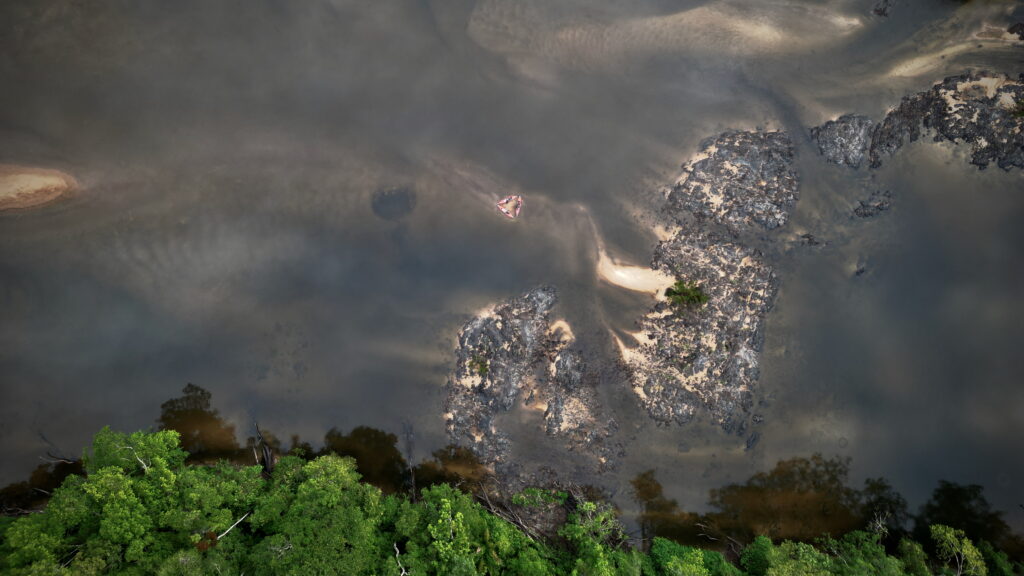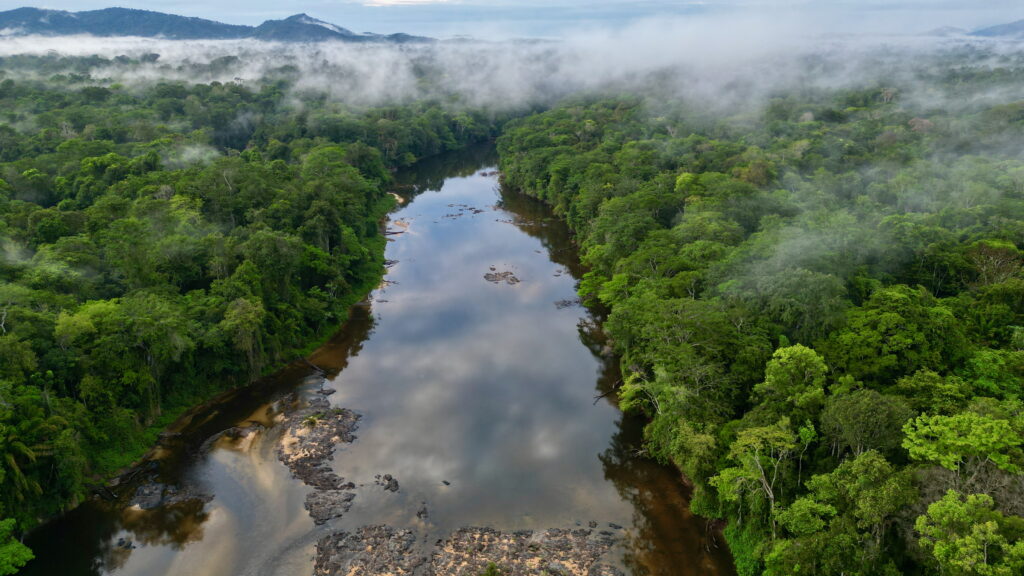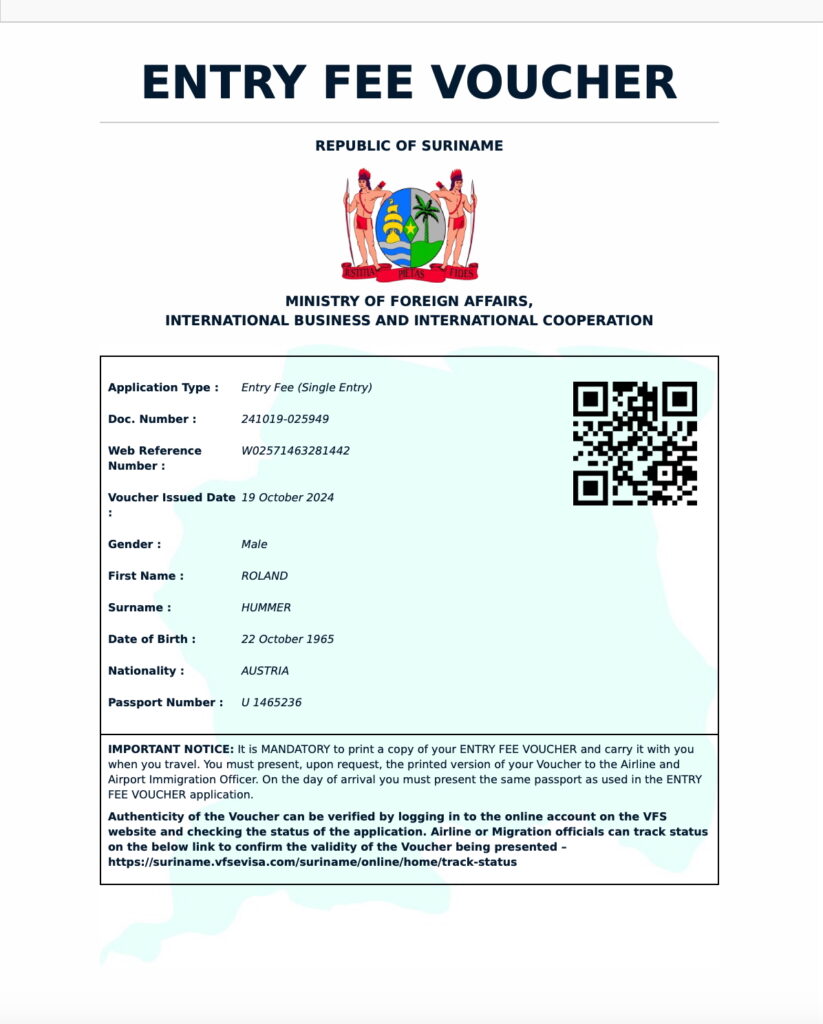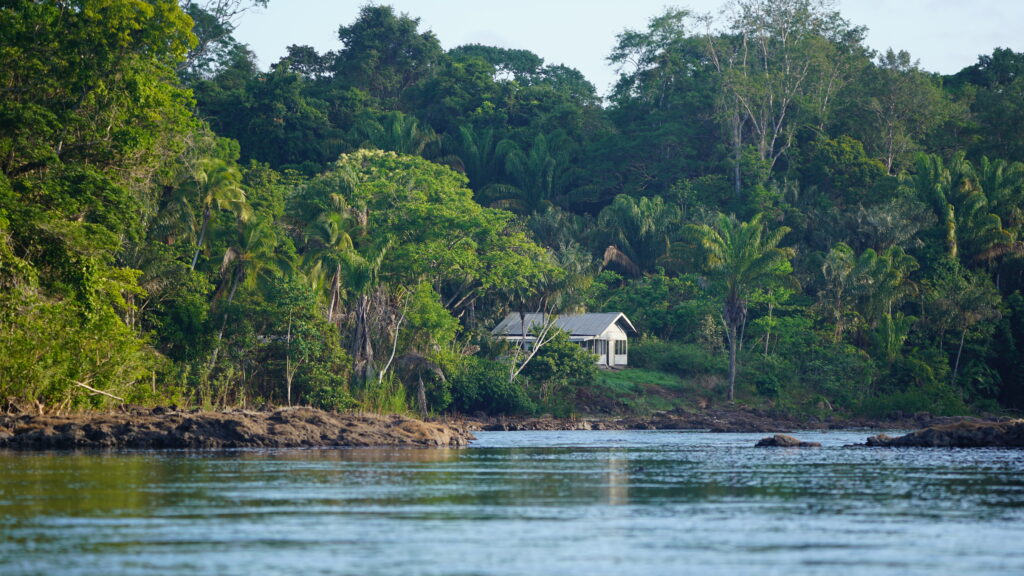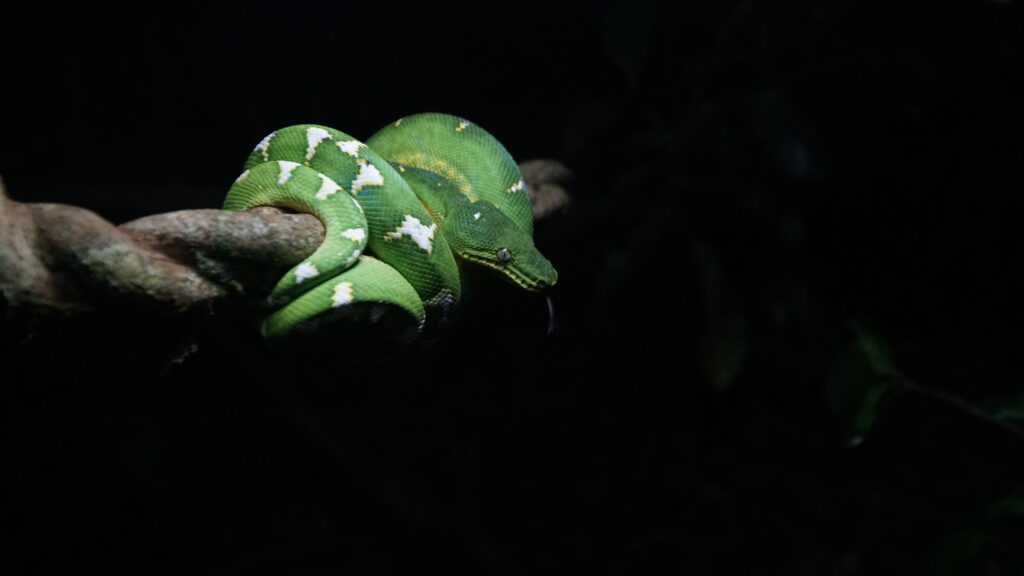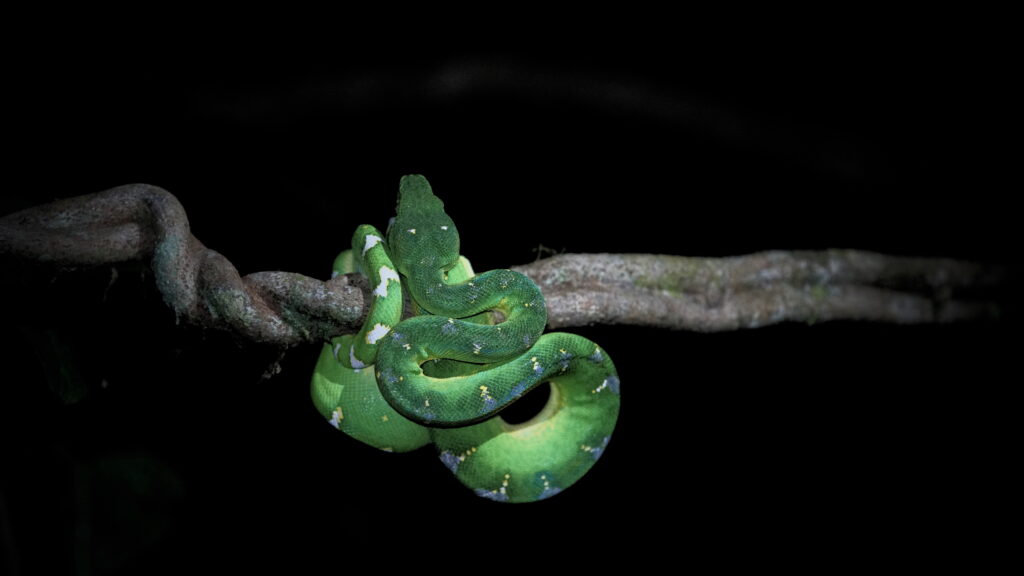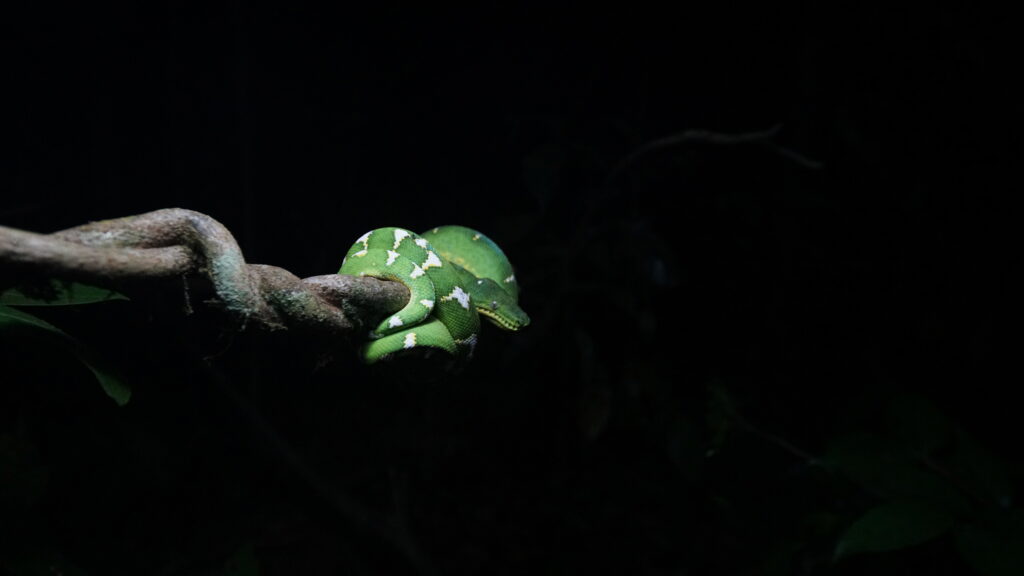Suriname, the greenest country on earth.
The engine’s hum reverberated in perfect sync with the rhythm of my heartbeat, like a hidden symphony resonating through my veins—a symphony composed of hope and uncertainty. In the distorted reflection of the window, I saw more than just my face. I saw the silhouette of an explorer, a seeker compelled by forces as ancient as the cosmos. Deep inside me, an ache stirred—not merely a yearning to witness new horizons but a primal desire to feel them, to absorb their essence, and to let their stories intertwine with the molecular fabric of my being.
The ten-hour train ride to Amsterdam Airport unfurled like a temporal corridor, giving me endless moments to traverse the vast landscapes of my mind. There was something oddly liberating about disconnecting from the daily grind—a kind of microcosmic rebellion against the oppressive tide of modernity. Even though my responsibilities were light, I longed to strip life down to its barest elements. Maybe it was just me, but I always felt that the mundane rituals of life siphoned away far too much of the finite energy that fueled my existence. This was especially true of the tangled web of bureaucratic monotony, a labyrinth of regulations that seemed designed to ensnare the soul. Passwords, demanded by unseen gatekeepers, had to be changed endlessly for “security.” Online forms were temperamental puzzles, deflecting progress with cookie banners and failed two-factor authentications, as though they conspired to tether me to their digital domain.
Each task, no matter how small—applying for a visa, filing a tax return, or verifying an invoice—felt like wading through an algorithmic quagmire. Hours dissolved into futility as I scanned documents, formatted PDFs, and decoded ever-shifting policies. Even travel, the very embodiment of liberation, began with shackles of bureaucracy: purchasing insurance, uploading medical records, and submitting entry forms to faceless digital portals. But the cruelest irony lay in the tools themselves—the technologies crafted to simplify our existence. Instead, they had transformed us into their servants. Automated systems demanded our data. Apps incessantly buzzed with reminders and deadlines. Websites ensnared us in loops of endless confirmations as if the machines were siphoning time itself from our lives. I wasn’t living for myself anymore. I was living for the algorithms, the policies, and the machines that had encased human life in an invisible, ever-tightening web.
And yet, here I was—on the edge of escape. Not from the machines, for they were everywhere, but into a world beyond their reach. A world of untamed variables, of unknown equations, of mysteries waiting to be solved. The hum of the train transformed into a pulse, driving me forward, propelling me toward something vast, something infinite. Perhaps I wasn’t running away from the world. Perhaps I was finally answering its call.
Daydreaming.
The journey itself was a prelude, a slow unfurling of dreams about the uncharted experiences ahead. I could already feel the magnetic pull of Suriname’s verdant heart—a rainforest blanketing over 93% of the country, one of the most untouched ecosystems on Earth. In my mind’s eye, I imagined a living cathedral of green, its canopy humming with life. Scarlet macaws cut through the air like streaks of fire, jaguars prowled in shadows, and delicate poison dart frogs glinted like living jewels. My pulse quickened at the thought of encountering creatures so extraordinary they bordered on myth. But with wonder came the shadow of danger: swarms of mosquitoes, carriers of unseen pathogens; anacondas coiled in silent ambush beneath murky waters; and venomous snakes, their cryptic patterns blending seamlessly into the foliage.
The rivers, winding like arteries through the jungle, beckoned me with the promise of discovery. I envisioned myself both captain and passenger, navigating these serpentine waterways into the unknown. Every twist and turn of the river was a challenge, every narrow trail a puzzle. My thoughts raced ahead, imagining the wild, untamed beauty awaiting me at every bend. The risks of this kayaking expedition were as vast and unpredictable as the jungle itself. Unable to fully grasp the dangers, I turned my attention to preparation, meticulously assembling my gear. The rivers and trails of Suriname were as unforgiving as they were beautiful, and no electrical outlet would be waiting at the edge of the jungle.
My clothing was pared down to the essentials: two pairs of rugged shorts, two long-sleeved shirts to shield me from the relentless insect onslaught, and a single pair of outdoor trousers that could withstand the jungle’s trials. The rest of my pack held survival tools—simple yet profound in their utility. A hammock to cradle me above the forest floor, a water filter to extract life from the rivers, waterproof containers to safeguard my equipment, and fishing gear to summon sustenance from the depths. Magnesium sticks for fire-starting and a machete for carving paths through the dense underbrush completed my kit. Every item I carried was more than just a tool; it was a lifeline, a thread connecting me to the primal challenge of survival. As I prepared for Suriname, I felt a fusion of exhilaration and fear. It wasn’t just the jungle I was entering. It was the unknown itself—unpredictable, untamed, and full of secrets waiting to be uncovered.
The Allure of the Unknown.
Suriname—a small country tucked along South America’s northeastern coast—concealed within its borders a history as rich and layered as the rainforest that now dominated its landscape. Once a Dutch colony shaped by the sugar trade and the horrors of slavery, it had evolved into one of the most culturally diverse nations in the world. But for me, Suriname’s true magnetism lay not in its bustling markets or colonial history, but in the mythical tapestry that enveloped its jungles. There, within the emerald shadows of the rainforest, the Maroons—descendants of escaped African slaves—had forged lives in harmony with nature. They were said to know paths invisible to satellites, trails etched into the earth by generations past. Equally compelling were the tales whispered by Suriname’s indigenous peoples, who spoke of spirits and legends woven into the very fabric of the jungle. Among these was the “Asema,” a vampiric entity said to stalk those who disrespected the forest’s sacred balance.
The rhythmic sway of the train transported me, not just across the land but into the depths of my imagination. I envisioned the rivers that would soon carry my kayak: veins of water coursing through an untamed wilderness. The landscape called to me—a world of contrasts where mist-draped forests gave way to roaring rapids, and the silence of nature was punctuated by the cries of unseen creatures. Suriname wasn’t just a country; it was a mosaic—a symphony composed of colonial influences, indigenous wisdom, and African resilience. The streets of Paramaribo, with their wooden colonial houses leaning like sentinels over vibrant markets, spoke of centuries of struggle and adaptation. Yet even the cultural richness of this city paled in comparison to the jungle, where the heart of Suriname pulsed with raw, unbridled life.
The rainforest was an ancient laboratory, a place where evolution’s experiments thrived unobserved. Its air, thick with humidity, carried the cries of animals whose calls seemed to echo across epochs. Rivers, the arteries of this living organism, rushed relentlessly, their banks alive with flora and fauna still confounding scientists. Here, every leaf concealed a secret, every shadow held the potential for discovery. Each tale shared by the Maroons, each whispered legend of the Asema, ignited a fire within me. I felt like a researcher at the edge of the known world, driven by an insatiable curiosity and an unspoken bond with the unknown. The geography of Suriname unfolded in my mind like a cryptic map, its layers revealing more questions than answers. This was more than an expedition; it was a quest for connection—to the land, its people, and the essence of exploration itself. The jungle wasn’t just a place; it was a mirror, reflecting the roots of what it meant to seek, to learn, and to grow.
Paramaribo.
On the banks of the mighty Suriname River, where the air hung heavy with the earthy scent of mahogany and the whispers of untamed jungle life, stood Fort Zeelandia—a sentinel of stone and memory. This venerable fortress, weathered by centuries, bore silent witness to the unfolding drama of history. It was here, amidst the wilderness and the surging river, that Paramaribo’s story began. What had once been a modest trading outpost founded by daring adventurers and cunning merchants had grown into a vibrant capital city, home to nearly 290,000 souls. Paramaribo, crowned a UNESCO World Heritage Site in 2002, wore its colonial past like an intricate tapestry woven into its very architecture. Wooden colonial houses lined its streets, their deep verandas and ornate details telling tales of an era when Dutch traders ruled the waves.
Suriname, the smallest independent nation in South America, is a paradox: a place where humanity and nature seem to coexist in a tenuous balance. With 93% of its land blanketed by rainforest, it is among the greenest countries on Earth—a living laboratory for biodiversity. Here, cultures collided and merged into an intricate mosaic. People of Indonesian, Indian, Chinese, Indigenous, African, and European descent lived side by side, their stories and traditions blending into a singular, vibrant identity. Yet the soul of Suriname was shaped just as much by its wild interior as its cultural diversity. Maroon communities, the descendants of enslaved Africans who escaped into the dense forests, carved out societies free from colonial rule. These resilient people, alongside Indigenous tribes, became guardians of the jungle, preserving the cultural and ecological richness that defined Suriname.
Arrival in Paramaribo. It was early December when my nine-hour flight from Amsterdam finally touched down in Paramaribo. The warm, tropical air enveloped me like an embrace, its humidity carrying the scent of rain and vegetation. The thermometer read 32° Celsius, but it wasn’t just the heat that struck me—it was the vitality of the place, a city alive with history and promise. As we drove through the streets of Paramaribo, past its colonial wooden houses and bustling markets, I felt a deep sense of anticipation. The rainforest awaited, a world teeming with secrets and challenges. Fort Zeelandia, the Maroon communities, the uncharted rivers—they all felt like chapters in a story I was about to live. This was more than a journey; it was a plunge into the unknown, a chance to explore not only a land but also the boundaries of my courage and curiosity. And as the hum of the city gave way to the distant rustle of trees, I knew that Suriname would reveal itself, piece by piece—a puzzle of nature, history, and resilience waiting to be solved.
A Touch of Adventure.
It was 6:30 a.m., and the world was still in darkness when Matthew, my guide, rolled up to the Sutopia Hotel in a rumbling Jeep. The gear check was done—headlamps, machetes, hammocks, provisions—all meticulously packed. My arsenal of cameras, lenses, and drones sat securely alongside, their weight a comforting reminder of the purpose that had brought me here. Each mile we traveled pulled us farther from the glittering city lights of Paramaribo, deeper into the shadowy embrace of the jungle. Ahead, the headlights carved through the inky void like blades of light, illuminating a path into the unknown.
Our destination was Brownsberg, perched high in the Brokopondo District, a bauxite plateau rising 1,690 feet above sea level. This rugged terrain, once humming with the clamor of mid-20th-century mining operations, had been a linchpin in Suriname’s economy, its rich bauxite deposits fueling the global hunger for aluminum. When the mines were abandoned in the 1970s, nature took back what was hers. Over decades, the forest crept in, shrouding the plateau in green and turning Brownsberg into a nature reserve renowned for its biodiversity. Today, its mist-veiled trails and hidden waterfalls serve as a sanctuary for wildlife and an irresistible lure for explorers.
We had chosen this place precisely for its untamed beauty. Brownsberg was a maze of trails that twisted and turned like veins through the jungle, each one leading to wonders hidden in the depths. Chief among them were Irene and Leo Falls—waterfalls that thundered through emerald canopies, their cascades wrapping the forest in a cool, ethereal mist. To a photographer, the reserve was a dream waiting to be captured: vibrant birds bursting like living jewels from the greenery, elusive mammals camouflaged in the shadows, and the ceaseless drama of nature unfolding before my lens.
But the journey itself was no less demanding than the destination. The steep, rutted trails were thick with mud, a quagmire that clung to the Jeep’s tires like a predator refusing to let go. Even our high-performance off-road vehicle struggled. Time and again, we found ourselves stuck, the engine growling against the unyielding grip of the muck. With each stall, we hauled out the winch, mud splattering across our faces and arms as we fought to free the Jeep. Every pull of the cable, every ounce of effort spent clawing forward, was a visceral reminder of the jungle’s power—and our fragile presence within it. Out here, there was no comfort to be found—only the raw exhilaration of survival. Every obstacle we overcame, every muddy inch we gained, felt like a victory snatched from the wilderness. Brownsberg was more than a destination; it was an initiation into the primal rhythms of the rainforest, a gateway to a world untouched by the passage of time. We were ready, not just to see Brownsberg, but to feel it—to let its wild beauty seep into our bones and remind us of what it meant to truly explore.
A Dangerous Hideaway.
The old, crumbling huts on Brownsberg stood like forgotten sentinels, weathered by decades of neglect. Yet their stillness was deceptive—an illusion masking the life that had claimed them. These structures, once built by human hands, now teemed with nature’s tenants: spiders spinning intricate webs in darkened corners, insects droning unseen in the shadows, and, as we would soon discover, venomous serpents lurking in silence. On our first night, as we switched on our headlamps, the heavy dampness of the air seemed to press closer, as if the rainforest itself were watching. Barely six feet from the shattered doorway, the light caught something glinting on the ground. There it was, coiled with chilling elegance, its scales a mosaic of earth tones that melted into the forest floor: a lancehead viper.
This snake, a master of camouflage and lethality, is one of the most feared predators of the rainforest. A member of the pit viper family, the lancehead is equipped with heat-sensing pits that allow it to strike with unerring accuracy, even in total darkness. Its venom is a biological weapon of horrifying complexity—hemotoxic compounds that shred blood cells, liquefy tissue, and disrupt the body’s ability to clot, ensuring internal hemorrhaging. For humans, however, a bite is a race against time—a deadly countdown without immediate antivenom. But it wasn’t just the viper’s venom that made it formidable. Its reputation as one of the most aggressive snakes in the jungle was well-earned. Their unblinking eyes seemed to peer into our very intentions, their stillness radiating a quiet menace that made the humid air feel electric. Each encounter was a moment suspended in time, a stark reminder of the razor-thin margin between observation and danger. From that evening on, every step became deliberate, every movement measured. Out here, the jungle’s hierarchy was unmistakable: we were interlopers, tolerated for now but never truly safe. The huts themselves transformed into a symbol of duality—a precarious refuge that offered both shelter and peril.
But the dangers weren’t confined to the wild. Brownsberg’s scars told another story, one carved by human hands. The relentless spread of illegal gold mining had gouged deep wounds into the land, poisoning rivers with mercury and driving animals from their habitats. This exploitation threatened not just the rainforest’s staggering biodiversity but also the communities that depended on it. Each scar was a sobering reminder of how human ambition could rival even nature’s fiercest predators. In Brownsberg, the jungle revealed itself in layers—its beauty inseparable from its danger, its power a force that demanded respect. Every step forward was a negotiation, every encounter a reckoning. Here, amidst the snakes and the scars, the rainforest spoke a single truth: it was a world that owed us nothing, yet offered everything to those willing to embrace its raw, unyielding spirit.
The Call of Gold.
In the depths of the surrounding forests, hidden camps pulsed with grim activity. Men, their faces etched with fatigue and desperation, toiled under perilous conditions, extracting gold from the earth using mercury. Illegal gold mining was no longer a quiet threat but an escalating crisis in Suriname. Thousands of miners labored in clandestine operations, their efforts often financed by shadowy international entities. The consequences were catastrophic. Mercury, a toxic heavy metal, leached into the soil and waterways, poisoning ecosystems and seeping into the food chain. Rivers once teeming with life became conduits of contamination, endangering the intricate web of flora and fauna. For indigenous communities that relied on these resources, the damage was both immediate and existential, their survival tied irrevocably to the land being torn apart.
The Call of the Jungle – The gas stove hummed like a distant heartbeat as the stew simmered, its spicy aroma mingling with the jungle’s humid breath. We ate in the flickering glow of our headlamps, the rhythmic clatter of spoons against metal bowls contrasting with the night’s cacophony. But the hunger we felt ran deeper than mere sustenance. It was a primal craving—for discovery, for answers hidden in the inky depths of the rainforest’s mysteries.
As the last bite disappeared, we moved with purpose. Cameras were sealed in waterproof bags, their lenses poised to capture the untamed night. The stove’s flame flickered and died, leaving a void quickly filled by the jungle’s symphony—the hum of insects, the distant mournful call of an owl. We laced up knee-high rubber boots, their soles ready to brave the sodden earth, and gripped our machetes—blades that were both tools and guardians in this untamed realm. The jungle consumed us instantly. The canopy above was a vault of black, impenetrable and vast, devouring even the moonlight. Only the piercing beams of our headlamps disrupted the abyss, illuminating fleeting snapshots of the world ahead. A sudden crack of a branch snapped the fragile veil of focus. We froze, muscles tensing as adrenaline surged. Was it a creature retreating from our presence, or something bolder, silently observing? The jungle seemed to hold its breath, the usual cacophony shrinking to a near-whisper. Our hands tightened on machete grips, hearts pounding in unison with the drumbeat of the wilderness.
Every step was a gamble, the nocturnal jungle alive with secrets. Shadows danced in the periphery of our vision, while the cries of unseen creatures punctuated the darkness like warnings. The jungle was a storyteller, each rustle of leaves or sudden burst of sound an unfolding tale, rich with meaning if only we could decode it. The silence wasn’t just an absence of sound; it was a presence of its own—a sentinel daring us to tread further. With each step, we ventured deeper into its realm, answering its unrelenting call. The jungle held us in its grip, a place where fear and wonder intertwined, urging us to uncover the truths hidden within its shrouded heart.
The Hunt for the Emerald Tree Boa.
The second day began as it would end—with an electric sense of adventure and the ever-present undercurrent of drama. Dawn unfolded heavy and humid, the jungle a cauldron of life. The sharp cries of toucans cut through a symphony of buzzing insects, while the distant rush of unseen water whispered promises of discovery. We moved cautiously, our eyes darting to every rustle and flicker of movement in the undergrowth. The wilderness was alive and unpredictable—sometimes playful, like the curious gaze of capuchin monkeys, but at other times unnerving, as the sudden snap of a branch sent a jolt of adrenaline through our veins.
By midday, we had carved a path to one of the rainforest’s many waterfalls. The journey was grueling, the air so thick it seemed to resist every breath. My clothes clung to my body, saturated with sweat, and the thought of a refreshing plunge drove me onward. Yet, when I finally stepped under the cascading water, there was no relief—it was as warm as the humid air itself, as though even the river had succumbed to the relentless tropical heat. Just as resignation settled over me, the sky grew restless. A low growl of thunder rolled through the valley, like the earth drawing a deep breath before unleashing its fury. Moments later, the storm broke. Torrential rain hammered the canopy, drenching us in a relentless downpour that was both cleansing and invigorating. By afternoon, we sought refuge beneath the dense canopy, preparing for the long night ahead. Our meals were simple but deliberate—calculated to sustain us. Breakfast was oats with raisins and honey, a quick burst of energy. Lunch was a handful of nuts and vibrant tropical fruit. Dinner, cooked over a flickering campfire, was either bulgur with beans or an improvised stew of freshly caught fish, rich and hearty.
Tonight was the night. The Emerald Tree Boa, a shimmering jewel of the rainforest, was our focus. Its scales, an iridescent green patterned with intricate white markings, rendered it invisible among the foliage. Native to South America’s rainforests, this arboreal predator was an evolutionary marvel. Stretching up to two meters in length, it coiled itself around branches with a vice-like grip, blending effortlessly into the shadows. As dusk surrendered to night, we prepared for the search. Headlamps illuminated the path ahead, cameras were readied, and the knowledge of the snake’s habits sharpened our resolve. The jungle at night was a different world—its sounds amplified, its creatures bolder. The cacophony of frogs, the rustle of unseen wings, and the eerie glow of reflecting eyes created a landscape both thrilling and foreboding. With each step into the darkness, we felt the pulse of the rainforest intensify. This was no ordinary search; it was a journey into the heart of the unknown, driven by awe, determination, and a deep respect for the untamed spirit of the jungle.
The Drumbeat of My Heart.
Hours slipped by as the ache in our necks became an unspoken testament to our determination. With headlamps casting flickering beams into the tangled canopy above, every sway of the branches made our breath hitch. Then, finally—an electric moment of discovery. My eyes locked onto a pattern too precise to belong to the chaos of leaves: a shimmering emerald-green interrupted by delicate white markings. Ten meters above us, she sat poised and regal—the Emerald Tree Boa. Caught in the pale glow of the headlamp, she seemed ethereal, a creature of myth brought to life, radiating both elegance and danger.
The Emerald Tree Boa is a masterpiece of evolution, revered for its vivid green scales adorned with lightning-like streaks of white or yellow. This arboreal predator is perfectly adapted to its life high above the forest floor, its color a near-invisible shield among the foliage. Reaching lengths of up to two meters, it spends its life coiled in the treetops, lying in wait for unsuspecting prey. Tonight, she was motionless, her body coiled in a hunter’s stance, her presence both commanding and serene.
Retrieving her required ingenuity. With machetes, we cut a long branch, crafting an improvised perch. The task was deceptively complex; each movement felt clumsy under the pressure of precision. Slowly, with painstaking care, we encouraged her to shift onto the new branch. Her movements were deliberate and fluid, as though time itself had slowed. Breath held, we waited as her tail, the last anchor to her original perch, unwound with an almost ceremonial grace. Fully coiled on our makeshift tool, she was ours to observe—an ambassador of the jungle’s primal beauty.
Gently, we transferred her to a lower branch, ensuring she felt no distress. Her scales glistened under the soft light, each detail a testament to nature’s artistry. She settled effortlessly, regal even in repose, a portrait of latent power and tranquil menace.
I readied my camera, heart pounding with a mix of exhilaration and unease. A flash was out of the question—it would shatter the moment. Instead, I relied on a tripod and a wide-angle lens, using a diffuser to soften the light. Every movement was deliberate as I crept closer, inching to within thirty centimeters of her coiled form. My senses buzzed with awareness, knowing her strike could be both lightning-fast and devastating. Yet, in that razor-edged moment, fear gave way to awe. The jungle held its breath, and I captured her image—raw, unguarded, and utterly magnificent. It was more than a photograph; it was a testament to the untamed spirit of the rainforest, a memory etched into my soul.
The Infinity of Nature.
The days spent immersed in the jungle’s emerald embrace seemed timeless, as though the forest had paused the world itself. But even the most captivating chapters must end. Our next destination was Fredberg—a 380-meter-high hill that rose like a monarch above the rainforest canopy. Its rocky summit offered more than just a view; it was an emotional crescendo, revealing the sprawling, endless green tapestry of the Amazon rainforest. From that vantage point, nature’s boundless beauty was both humbling and overpowering, a visceral reminder of its grandeur and our fleeting place within it.
Fredberg was a crucible of life, a vibrant mosaic of species in constant motion. High in the treetops, the Guiana black spider monkeys swung with breathtaking agility, their calls resonating like ancient songs through the canopy. The Guianan cock-of-the-rock, with its fiery orange plumage, blazed against the dense green, a living ember in the jungle’s depths. But the beauty here came with a razor’s edge—hidden in the undergrowth lurked the bushmaster, one of the largest and deadliest snakes in the Americas. Silent and patient, it was a predator that demanded respect. Around these iconic creatures swirled a kaleidoscope of others: iridescent frogs glimmering like jewels, raucous parrots breaking the air with their cries, and the ghostly presence of jaguars slipping through the shadows like whispers. This wasn’t just a jungle; it was a living, breathing symphony of life where each organism played its part with precision.
Fredberg’s soundscape was an unending marvel. By day, it echoed with the guttural roars of howler monkeys and the melodic trickling of hidden streams, each sound a chapter in the jungle’s story. But as night descended, a different orchestra emerged: the chirping crescendo of crickets, the haunting rhythm of owl calls, and the occasional snap of a branch, hinting at an unseen visitor. These sounds weren’t mere background—they were messages, guides, and warnings in this untamed world.
Reaching Fredberg, however, meant conquering one last trial: the descent from Brownsberg to the main road. To call it a “drive” would diminish the ordeal; it was a raw, grueling battle against nature. Our off-road vehicle became both ally and adversary, skidding through deep mud trenches and wrestling against gravity at precarious angles. With machetes, we hacked at overhanging branches, clearing a path inch by painstaking inch. Every jolt, every tilt of the vehicle felt like a gamble against disaster. Yet, it was this very struggle—the unrelenting challenge of the jungle—that etched itself into memory. Each obstacle we overcame wasn’t just a victory over terrain; it was a triumph of spirit in the face of nature’s relentless power.
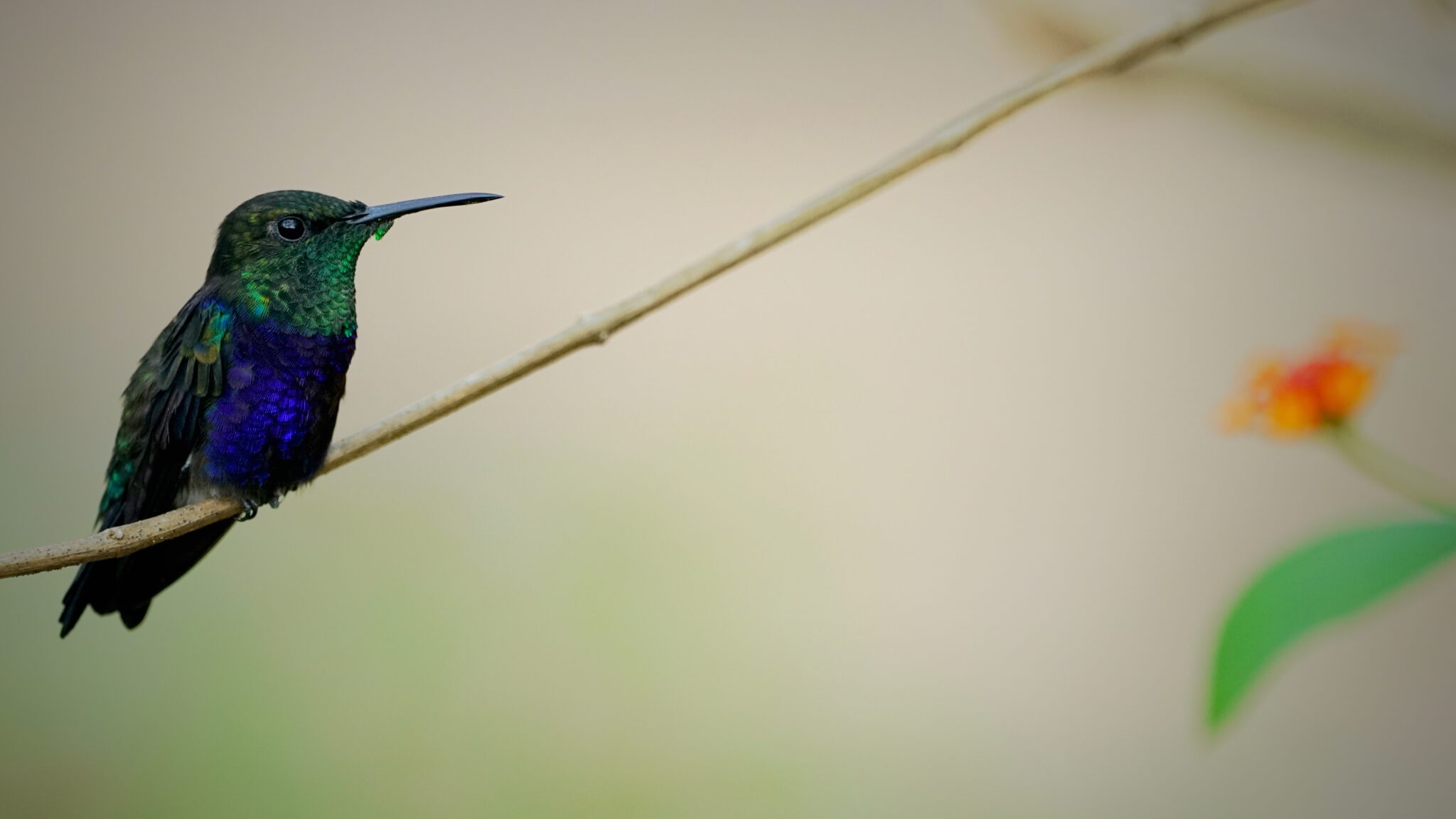
Instinctively.
Fredberg, named after one of the first explorers to chart this region, was not merely a patch of wilderness—it was a realm of discovery. From this vantage point, the secrets of the Surinamese rainforest lay within reach, a place that lured both nature enthusiasts and intrepid adventurers alike. To step into Fredberg wasn’t just to venture into the wild, but to embark on an odyssey of self-discovery. The jungle demanded your total presence—every step, every movement had to be deliberate, attuned to the pulse of the forest. One misplaced touch or sudden misstep in the thick undergrowth could set your heart racing. In this primal world, every rustling leaf or shadowed figure turned you into a creature of instinct—caught between fight or flight, always ready to react. And in this raw, untamed wilderness, you didn’t just learn about nature; you came face-to-face with the wildness within yourself.
The jungle moved to its rhythm, a heartbeat that only the brave and the patient could sense. That day, machetes in hand, we hacked our way through the dense labyrinth of green. Our goal was to find a secluded spot near the river to set up camp. Today, we made a bold choice—we left behind the tarp, surrendering ourselves to the relentless monsoon rains. The sight of the river’s winding curves, however, was too breathtaking to miss. The mosquito net, though, remained non-negotiable, our last defense against the ceaseless onslaught of jungle pests. As night fell, the oppressive heat offered no respite, and I succumbed to a restless sleep, my body too weary to fight. Yet, the jungle’s constant soundtrack—the crackling of branches, the rustling of unseen creatures, the eerie cries in the distance—kept me teetering on the edge of wakefulness. The only sound that offered reassurance was the distant roar of the howler monkeys, their calls reverberating through the darkness.
In the morning, we built a fire, its crackling flames offering fleeting comfort and the promise of normalcy. But today was no ordinary day. The following two days would take us into the chest-deep waters of the river, searching for an anaconda—the anaconda, the largest snake on Earth. The thought of plunging into the dark, muddy waters sent a shiver through my spine. But that was why I was here—to embrace the danger, the unknown, and the wildness of Suriname. To encounter an anaconda in its natural habitat was my dream, my driving purpose.
The Endangered Wilderness.
Our gear was minimal—sandals, shorts, a long-sleeved shirt, and a cap to shield me from the sun, along with my camera, safely stashed in a waterproof bag. That was all I needed. Breakfast was routine: oatmeal with honey, nuts, and raisins—simple, nourishing, and efficient. It was a life designed for survival and purpose, streamlined by the wild environment that demanded nothing less.
As I waded into the river, it felt as though the very water was alive, whispering against me. The coffee-brown surface hid everything beneath—decaying branches, unseen carcasses, and the lurking, silent threat of a snake. Every brush with the water, whether a rotting leaf or a submerged branch, made my pulse quicken. The ground beneath me was soft and treacherous, a thick, sticky mixture of mud and decomposing leaves, as if the earth itself was trying to pull me down. With every step into the murky depths, the tension grew, but so did the fascination. The jungle wasn’t merely a backdrop; it was an organism—a living, breathing force that enveloped me. The search for the anaconda wasn’t just a pursuit; it was an initiation, an encounter with an ancient, primordial power that pulled me deeper into the wild, testing both my courage and my will.
Hours passed in the river, yet we had covered only a few miles. The terrain was unforgiving, and each fallen tree in the water turned our progress into a slow, grueling task. But it wasn’t just the obstacles of nature that required our focus; we had to stay constantly alert, scanning for patterns and colors—signs of the jungle’s many creatures. Suriname’s ecosystem, rich in diversity, demanded this level of attention. Its complexity and its fragility would soon become clearer, as the threats to this wilderness were ever-present.
Biodiversity in Suriname faced relentless threats. Habitat destruction, driven by the growing tide of gold mining, was a significant peril. Mangrove forests were being depleted, and invasive species wreaked havoc, further pushing native populations to the edge. Illegal hunting and fishing compounded these problems. Suriname is home to endangered species like the giant grouper and the tapir, whose survival is increasingly uncertain as their habitats are ravaged. The delicate balance of this ecosystem, where each creature plays a pivotal role, was being disrupted, and its consequences were profound—every step into the river reminded me of the fragility of life here.
Gigantic Machines.
Illegal gold mining in Suriname has become one of the most urgent threats to the country’s delicate ecosystems and its Indigenous and Maroon communities. Gold mining has long been a staple of Suriname’s economy, but its unregulated expansion in recent years has spiraled into a crisis. Vast sections of the rainforest are scarred by gold pits and crisscrossed by muddy trails gouged by mining machinery. Once pristine rivers are now tainted with mercury—a toxic substance used to separate gold from ore. The damage doesn’t stop at the water; mercury accumulates in fish, contaminating the local food chain and endangering the health of the populations that rely on these fish for sustenance.
The situation is further complicated by the influx of Chinese miners and business operators. Operating largely outside the law, they have gained significant control over the gold industry, bringing in heavy machinery and bypassing regulations by bribing officials. This unchecked exploitation has not only intensified deforestation but also accelerated pollution. As local communities clash with these operators, the environment continues to deteriorate, while people—already living on the edge—find themselves increasingly marginalized, caught between environmental destruction and social instability.
Beyond the gold fields, Suriname stands on the edge of another economic frontier: offshore oil drilling. The discovery of vast oil reserves in Suriname’s territorial waters promises to reshape the nation’s economy, with companies like TotalEnergies and ExxonMobil pouring billions into exploration. For a country with limited economic diversity, this oil boom could provide critical funding for infrastructure, healthcare, and education. But this potential windfall comes with immense risks. If the industry is mismanaged, Suriname could face the same environmental and social pitfalls that have plagued neighboring countries—corruption, degradation, and an overdependence on a single resource. Furthermore, oil drilling threatens Suriname’s marine biodiversity, with the prospect of damaging vital fish stocks and the livelihoods of local fishermen.
The convergence of illegal gold mining, unregulated foreign influence, and the impending oil rush paints a sobering picture of Suriname’s future. The country stands at a critical juncture, where the choices made today will determine whether it preserves its unparalleled natural beauty or falls victim to resource exploitation, sacrificing its environment and its people in the process.
Between Tapirs and Anacondas.
The Indigenous communities of Suriname were the true keepers of ancient knowledge—knowledge that long predated modern science. Their bond with nature was not just practical but spiritual, as if their very existence was intertwined with the pulse of the jungle itself. They understood the rhythms of life and death, the subtle balance that sustained the rainforest. Their knowledge of medicinal plants was a living, breathing encyclopedia, passed down through generations, and their sustainable hunting techniques were a delicate dance—extraction and preservation in perfect harmony. In their wisdom lay the essence of survival, not just for their own people, but for the countless species that would have vanished without their stewardship.
But within this harmony, fractures were beginning to appear, and I witnessed them firsthand. The tapir, often called the “gentle giant” of the jungle, had become one of the casualties of these fractures. Suriname was the only country in South America that allowed tapir hunting during specific seasons and in certain regions. What once seemed like a balanced approach soon turned into a threat: hunting seasons were ignored, and regulations were disregarded. Illegal hunting ran rampant, and the tapir population dwindled. When I first encountered a slain tapir, it struck me deeply—not just as a physical loss, but as a blow to the dignity of the jungle and its guardians. The wound was not just to the species, but to the very soul of the rainforest.
But the call of the wild was undeniable, and I pressed on, driven by the mysteries that still awaited. My goal was an ancient creature that had haunted my dreams since childhood—the anaconda. To many, it was a monster, a terror of nightmares. But to me, it was a symbol of life itself: vast, enigmatic, powerful. My search began with equal parts awe and trepidation. The river was my companion and adversary, its black waters concealing unknown dangers. Every step through the murky undergrowth seemed to promise an encounter—either too close or just out of reach. This hunt was not one of weapons, but of observation, patience, and respect for a creature that embodied both triumph and humility in equal measure.
The tales I share are not just about my journey through the jungle—they are a glimpse into its beating heart. Every encounter, whether with a tapir or an anaconda, revealed something profound about the wildness of this world—and something deeper about myself.
Clueless.
Matthew and I ventured into the suffocating darkness, our usual gear in tow: rubber boots, machetes, headlamps with spare batteries—and for me, a camera, wide-angle lens, tripod, and diffuser to soften the harsh light for my shots. The swamp was a world we knew intimately, a nightmarish beauty we’d come to navigate with eerie precision. Waist-deep in the murky water, I tried to push aside the gnawing voice inside me, warning of the dangers lurking in the shadows. But deep down, I knew better. This was the rainforest—untamed, unpredictable. The faintest splash could signal a caiman moving closer, or a stingray, its smooth form slicing through the water.
But tonight, the stakes were higher. It was our final opportunity to encounter the anaconda, and nothing was left to chance. To maximize our chances, we split up. Matthew headed upstream on one side of the river, while I forged my path through the dense underbrush on the other. Forty meters apart in the darkness felt like an abyss. Soon, his headlamp disappeared into the void. The swamp devoured all light and sound. I was alone. The darkness pressed in around me, thick with anticipation. Each step became a delicate negotiation between fear and resolve, the heavy, murky water closing in like a silent predator. My senses were heightened, and the hours stretched on. I scanned the water, my mind locked on the scale patterns that might reveal the serpent’s presence. The darkness seemed to pulse with movement, but it was only the reflections playing tricks on me. Every flicker of light had my heart racing, as I desperately searched for the unmistakable signs of the anaconda.
Anacondas—giants of the snake world—embody the raw power of the rainforest. These colossal creatures can grow up to seven meters long and weigh over 200 kilograms, making them the heaviest snakes on Earth. Yet despite their size, they remain enigmatic, silently patrolling the riverbanks where they reign as apex predators. Capable of ambushing prey as large as deer, capybaras, or even jaguars, they strike with crushing force, a display of nature’s might and elegance in equal measure. For us, encountering an anaconda wasn’t about domination or conquest—it was about reverence. These snakes are integral to the balance of the rainforest, regulating prey populations and maintaining the delicate web of life. But to step into their domain is to face the humbling truth that, here, humans are not the top of the food chain. As I stood there, waist-deep in the water, the darkness pressing in on all sides, I felt the weight of that truth. The rainforest wasn’t merely a backdrop; it was alive—watchful, breathing, and full of stories written in the ripples of the water.
A Moment for Eternity.
The scene before me was one I had envisioned countless times in my mind, yet nothing could have prepared me for the reality—more vivid, more alive, almost surreal. There it lay, the anaconda, bathed in the pale glow of my headlamp. Its features—olive-green skin, black spots forming a map, and those haunting yellow eye spots—were instantly recognizable. It was a creature I had studied with obsessive precision, and now it was before me. I felt a strange calm, a quiet anticipation, as if this moment had been preordained, the inevitable climax of a journey I had already lived in my thoughts over and over again.
It rested in a small, rocky pool, fed by the river. A young one, I judged—no longer than 160 centimeters. At first, it was just its eyes and nostrils, barely breaking the surface, the subtlest hint of its presence. Then, as the light from my headlamp slowly swept across it, the full extent of its power and elegance emerged. The moment felt like a living sculpture, frozen in time. The joy of discovery surged through me—an intoxicating mix of awe and triumph that made every hardship of the past days worth it. Time seemed to slow as I contacted Matthew on the radio. When he crossed the river and emerged into the dim light, his grin was unmistakable. Matthew, a lifelong snake enthusiast turned zoologist, shared my fascination with these creatures.
As he began explaining the intricate details of the anaconda’s biology, I edged closer, my senses heightened. The water was clear, disturbed only by the occasional falling leaf, and the anaconda lay still, coiled in perfect loops, as though sculpted by the hand of nature itself. The moment was burned into my memory, an indelible imprint of wonder and respect. Matthew spoke of anacondas’ evolutionary brilliance—how they are constrictors, not venomous, their deadly embrace a testament to nature’s ingenuity. With each exhale of their prey, they tighten their grip, stopping the breath and circulation, until life is extinguished. I had read about this, studied it, but now, in the presence of this giant, I felt the raw power of its reality deep in my bones.
In the days leading up to this moment, I had practiced with smaller snakes, learning their patterns and movements to prepare. But nothing could match the intensity of facing this creature. My hand trembled slightly as I focused on the crucial instant, feeling the weight of nature’s force pressing in. Slowly, carefully, I inched closer, my heart pounding in my chest. Despite the fear, a strange clarity washed over me—I was completely focused, completely present.
Between Worlds.
How often are we in the moments between two worlds? These in-between spaces—where the pressures of daily life meet untamed freedom, where the familiar collides with the unknown—form the very core of the adventure we call life. Suriname’s rainforest, with its infinite shades of green and untrodden paths, became the perfect metaphor for this state: a land brimming with danger, beauty, and challenges that forced me to confront my limits.
Each stroke of the paddle on the winding rivers felt like a return to something primal, something easily forgotten in our fast-paced, tech-driven world. The days merged into a relentless cycle of sweltering heat, constant vigilance, and careful navigation. But amid the hardships, some moments made every ounce of effort worthwhile: the fleeting gleam of a jaguar’s eyes in the dim glow of my headlamp, the hypnotic rhythm of a tropical rainstorm tapping on my hammock, and the profound silence of the jungle, where an entire world seemed to exist in suspended time.
Suriname taught me that true adventure isn’t found by avoiding danger, but by choosing to face it head-on. The stories of the Maroons and indigenous people who shared their wisdom with me became a second voice, constantly reminding me of respect, connection with nature, and the humility required to survive as a stranger in an ancient, living system.
Now that I’ve returned, one truth remains: the journey doesn’t end. It lingers in the memories of the rainforest etched into my soul, and in the insatiable thirst to keep exploring—whether for stories, for answers, or for a deeper understanding of myself. This wasn’t the end, but a new beginning, the next step on a path as unpredictable as the waters I navigated. It’s a call I can’t ignore—and perhaps, one I don’t want to.
Exciting news! A second book about my unforgettable journey along the Saramacca River in Suriname is in the works. Get ready to dive deeper into the heart of the rainforest, where every bend in the river holds a new mystery. Here are two teasers to spark your curiosity!
Suriname showed me that true adventure does not lie in the avoidance of danger but in the willingness to face it. The stories of the Maroons and Indigenous people who accompanied me on my journey became a second voice in my head—they whispered of respect, of connection with nature, of the humility needed to survive as a stranger in an ancient system.
Amidst these adversities, there were moments that justified every effort: the gleam of a jaguar’s eyes in the pale light of my headlamp, the rhythmic drumming of a tropical downpour on my hammock, the unwavering silence of the jungle, which holds an entire world within it. A journey never truly ends, and Suriname has left its mark on my soul. Ready for the next step? The story begins here.

